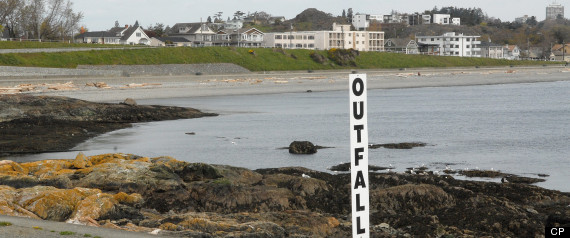CRD Sewage Treatment Plan: Background
The Capital Regional District (CRD) is currently considering a proposal for a $783 million sewage treatment facility at McLoughlin Point. This page will provide a concise overview of the issues surrounding sewage treatment and explain why a proposal is being considered. It will also highlight some of the concerns that have been raised about sewage treatment and the current proposal.
At present, Victoria is dumping raw, screened sewage into the Strait of Juan de Fuca. Such sewage contains a mixture of organic waste and marine toxins (pharmaceuticals, fire retardants, other toxins etc.). About 50% of the marine toxins are attached to the biosolids, the other 50% are mixed in with the liquid waste.
Numerous local ocean scientists (including some in my own department at UVic) have pointed out that the Strait of Juan de Fuca is well mixed and highly oxygenated. This means that the organic components of the waste dissipate and decay very rapidly. But what also matters is the persistent discharge of marine toxins. These can move up the food chain and congregate in large predators. Continuing to release these into our environment is unsustainable.
The proposal currently under consideration is for a secondary sewage treatment system that would treat the organic waste. The remaining wastewater after secondary treatment would be discharged into the Strait of Juan de Fuca. The discharged wastewater still contains about 50% of the marine toxins mentioned above. In other words, the proposed secondary treatment facility effectively deals with the organic waste (which is not, scientifically speaking, a problem because of our highly oxygenated waters) but doesn’t deal with the chemical waste (that is a problem). In order to also treat the chemical toxins, the CRD would need a tertiary treatment system.
Now by itself, science cannot prescribe policy solutions; it can only inform policy discussions. There are additional issues that the science does not answer that need to be recognized in the public debate. These include the facts that:
- Funding for a new sewage treatment system has been secured from provincial and federal sources;
- The existing sewage system does not meet current provincial legislation and federal Fisheries Act requirements;
- The CRD sewage issue has become a sore point with the tourism industry;
- The CRD is expected to grow significantly in the years ahead thereby increasing the amount of sewage discharged into the Strait;
There are also other environmental problems associated with wastewater in the CRD. These include the fact that storm water and sewage lines are shared in parts of Oak Bay. This means that in large rainfall events, raw sewage is released through outfalls onto some local area beaches.
In addition, much of our storm water run-off is discharged directly into local waters. This storm water is laden with toxins washed off our streets and driveways, and the run-off is not fully addressed by this current proposal.
Comments are closed.




